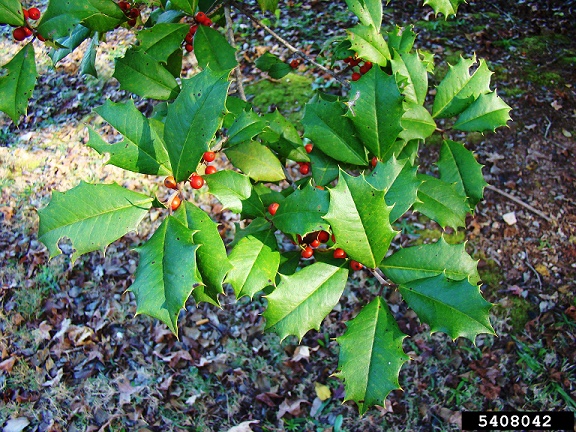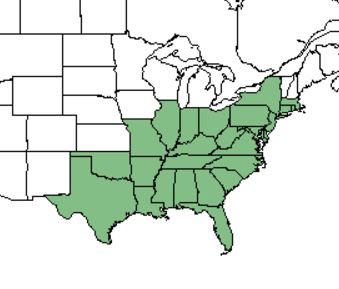Difference between revisions of "Ilex opaca"
(→References and notes) |
(→Taxonomic notes) |
||
| Line 20: | Line 20: | ||
Common name: American holly | Common name: American holly | ||
==Taxonomic notes== | ==Taxonomic notes== | ||
| + | Synonym: ''Ilex opaca'' var. ''opaca'' | ||
| + | |||
==Description== | ==Description== | ||
<!-- Basic life history facts such as annual/perrenial, monoecious/dioecious, root morphology, seed type, etc. --> | <!-- Basic life history facts such as annual/perrenial, monoecious/dioecious, root morphology, seed type, etc. --> | ||
Revision as of 19:34, 15 March 2016
| Ilex opaca | |
|---|---|

| |
| Photo by Rebekah D. Wallace, University of Georgia, Bugwood.org | |
| Scientific classification | |
| Kingdom: | Plantae |
| Division: | Magnoliophyta - Flowering plants |
| Class: | Magnoliopsida - Dicotyledons |
| Order: | Celastrales |
| Family: | Aquifoliaceae |
| Genus: | Ilex |
| Species: | I. opaca |
| Binomial name | |
| Ilex opaca Aiton | |

| |
| Natural range of Ilex opaca from USDA NRCS Plants Database. | |
Common name: American holly
Contents
Taxonomic notes
Synonym: Ilex opaca var. opaca
Description
I. opaca is a upright evergreen tree that is commonly known as the Christmas holly. It is the only native holly in the U.S. to have spiny green, leathery leaves and bright red berries [1]. The fine-textured wood is ideal for inlays in cabinetwork, carvings and vanier [2].
“Trees or shrubs, usually with imperfect flowers. Leaves simple, entire, serrate, dentate or crenate; stipules obsolete. Flowers axillary, solitary, fascicled or in cymes, 4-7 merous, 4-8 mm broad; petals united at the base, imbricate in bud; pistillate flowers usually with nonfunctional stamens; anthers opening lengthwise; stigmas 4-7, essentially sessile. Drupe red, black or rarely yellow or white. Seeds with hard, bony endocarp (pyrenes), often grooved or ribbed on the back, 4-7 in a fruit, 1 in each locule.” – Radford et al 1964
"Medium or large tree, usually with a columnar or conical growth form, twigs minutely pubescent, glabrate. Leaves coriaceous, evergreen, dull above, elliptic to elliptic-obovate, 4-10 cm long, 2-5 cm wide, dentate with few to many sharp spine-tipped teeth or sometimes entire with only a single apical spine, revolute. Pedicels usually densely canescent. Staminate flowers in axillary, pedunculate, simple or compound cymes; sepals 4; petals 4, white; stamens 4. Pistillate flower 1-3 (when 3, in a simple cyme) in leaf axils or at nodes just below the leaves; sepals 4; petal 4 white; stamens 4. Drupe red or orange, rarely yellow, usually dull, globose or slightly ellipsoid, 0,7-1.2 cm long; pyrenes 4, irregularly grooved on the back, 6-7 mm long." - Radford et al 1964
Distribution
Ecology
Habitat
Ideal habitats are moist, acidic, well-drained soils such as mesic hammocks, sand pine-oak woods, bordering floodplains, deciduous woodlands on limestone, and mesic steepheads (FSU Herbarium). Soils include sandy loam, loam, and medium loam; however, does not favor well in clay[2](FSU Herbarium).
Associated species include Pinus taeda, P. echinata, P. glabra, Quercus hemisphaerica, Q. nigra, Q. incana, Q. virginiana, Cornus florida, Liquidambar styraciflua, Magnolia grandiflora, Sassafras albida, Vaccinium arboretum and V. stamineum (FSU Herbarium).
Phenology
Has been seen flowering from March through July (FSU Herbarium). This is a dioecious species, with separate male and female plants. The flowers of both sexes retain both male and female reproductive organs, however, only one is reproductively functional. Female flowers open synchronously, with each flower only lasting a day; while males open flower buds asynchronously throughout the season, with these flowers typically lasting 3 to 4 days. The fecundity of the female flowers is constrained by pollinator service, light, nutrient and water levels. Flowers are borne on the green stems of the new year's growth and can be seen March through July. The fruit is a red drupe containing four pyrenes (Carr 1991).
Seed dispersal
The fruit is a four-seeded drupe that is dispersed by birds and small mammals[3]. Large winter-migrating flocks of small birds such as cedar waxwing and American goldfinch, are one of the most important seed dispersal mechanisms for this species [3].
Seed bank and germination
Germination is epigeal and very slow, usually requiring 16 months to 3 years. Overwinter storage or cold, moist stratification improves germination rates[3]. Carr (1991) showed that embryonic development in vitro is suppressed by light.
Fire ecology
I. opaca is very susceptible to fire and is typically absent from regularly or even occasionally burned forest. The bark is easily injured by fire and large trees may be killed by light fires in the understory[3].
Pollination
The following Hymenoptera families and species were observed visiting flowers of Ilex opaca var. arenicola at Archbold Biological Station (Deyrup 2015):
Apidae: Apis mellifera, Bombus impatiens
Colletidae: Colletes banksi, C. brimleyi
Halictidae: Augochloropsis metallica, Augochloropsis sumptuosa
Megachilidae: Megachile petulans
Sphecidae: Cerceris rozeni, Gorytes dorothyae ruseolus, Hoplisoides denticulatus denticulatus, H. placidus placidus, Liris argentata, L. muesebecki, Pseudoplisus smithii floridanus, Tachysphex apicalis, T. similis, Tanyoprymnus moneduloides
Vespidae: Pachodynerus erynnis
Use by animals
Holly cavities provide nesting habitat for the red-cockaded woodpecker[4]. Groves provide shelter to red-eyed towhee, bluebirds, cardinals, white throated sparrow, and robins (Petrides 1942).
The spines on the leafs are used as a defense against herbivory (Ehrlich and Raven 1967).
Diseases and parasites
It is susceptible to many different diseases such as: 14 species of leaf spot fungi, 6 species of black mildews, 2 powdery mildews, leaf drop, leaf scorch, and chlorosis[1]. Many insects also plague I. opaca such as: the southern red mite, which reduces the leaf and twig growth; the native holly leaf miner which causes leaves to drop prematurely; and the holly midge, which feeds on the berries hindering them from turning red [3].
Conservation and Management
Cultivation and restoration
I. opaca is closely associated with Christmas and in the past has been threatened by over harvesting for Christmas decoration[3].
Photo Gallery
References and notes
Carr, D. E. (1991). "Sexual Dimorphism and Fruit Production in a Dioecious Understory Tree, Ilex opaca Ait." oecologia 85(3): 381-388.
Carr, D. E. (1991). "Sexual Dimorphism and Fruit Production in a Dioecious Understory Tree, Ilex opaca Ait." oecologia 85(3): 381-388.
Deyrup, M.A. and N.D. 2015. Database of observations of Hymenoptera visitations to flowers of plants on Archbold Biological Station, Florida, USA.
Florida State University Robert K. Godfrey Herbarium database. URL: http://herbarium.bio.fsu.edu. Last accessed: January 2016. Collectors: Loran C. Anderson, W.W. Ashe, Tom Barnes, Leonard J. Brass, A.F. Clewell, K. Craddock Burks, S. Clawson, George R. Cooley, G. Fleming, P. Genelle, J.P. Gillespie, Robert K. Godfrey, Bruce Hansen, P. Hilsenbeck, R. Hilsenbeck, Walter S. Judd, Gary R. Knight, R. Komarek, R. Kral, H. Kurz, O. Lakela, Lloyd, James B. McFarlin, Lionel Melvin, Marc Minno, Richard S. Mitchell, J. Poppleton, Gwynn W. Ramsey, Paul Redfearn, George Reed, George Robinson, H. Shinners, A.G. Shuey, Cecil R. Slaughter, Robert F. Thorne, Kenneth A. Wilson, Carroll E. Wood, R. Wunderlin, and T. Wunderlin. States and Counties: Florida: Baker, Bay, Citrus, Columbia, Dixie, Escambia, Franklin, Gadsden, Highlands, Jackson, Jefferson, Lake, Leon, Levy, Liberty, Marion, Okaloosa, Orange, Polk, Santa Rosa, Suwannee, Volusia, Wakulla, Walton. Georgia: Grady.
Forrester, J. A. and D. J. Leopold (2006). "Extant and Potential Vegetation of an Old-Growth Maritime Ilex opaca Forest." Plant Ecology 183(2): 349-359
Gargiullo, M. B. and E. W. Stiles (1993). "Development of Secondary Metabolites in the Fruit Pulp of Ilex opaca and Ilex verticillata." Bulletin of the Torrey Botanical Club 120(4): 423-430.
Petrides, G. A. (1942). "Ilex opaca as a Late Winter Food for Birds." The Auk 59(4): 581-581.
Radford, Albert E., Harry E. Ahles, and C. Ritchie Bell. Manual of the Vascular Flora of the Carolinas. 1964, 1968. The University of North Carolina Press. 679-81. Print.
Supnick, M. (1983). "On the Function of Leaf Spines in Ilex opaca." Bulletin of the Torrey Botanical Club 110(2): 228-230.
Supnick, M. (1985). "The Mean Inner Radius of Sun and Shade Ilex opaca Leaves." American Journal of Botany 72(9): 1490-1491